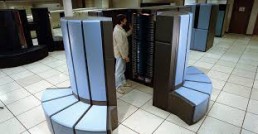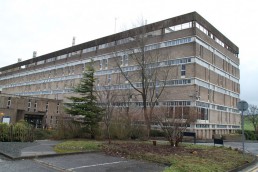A long time ago I was a freshman at Edinburgh University. I say I was a freshman, but due to the different terms between the English and Scottish schooling systems, I ended up going straight into the second year of four-year Computer Science course.
As I began attending my first lectures it became obvious this was going to be tough! There was an assumption that everyone had attended the previous year’s lectures, and this was a continuation. It also didn’t help that my first lecture was being given by someone with a broad Scottish accent. Not only did I not understand what they were talking about – I couldn’t understand what they were saying either!!
The next day I decided to take a different route to the lecture theatre. I was intrigued by a building labelled EPCC (Edinburgh Parallel Computing Centre) so thought I’d take a look. Inside was a rabbit warren of corridors, but eventually I came across a single long corridor with glass windows all the way down the left-hand side.
Walking down this corridor took my breath away. Behind the glass windows was one of the largest collections of high-power supercomputers in the world! A huge room – full of them!


Super Computers owned by companies and organizations from all over Europe were housed here. Edinburgh’s EPCC group ran and maintained these expensive machines in this low-key, non-descript building.
The sight before me was incredible. I’d only read about such machines, and here in front of me was a collection of some of the most powerful machines in the world. One machine in particular stood out – a black and red beast from a company called Cray Supercomputers. I was instantly hooked and forgot about the difficult course ahead!
Traditionally supercomputers were rows of cabinets filled with processors. This Cray computer broke with tradition and took on a horseshoe shape, allegedly to shorten the electrical path between processors. I’d seen one at the cinema previously – it was featured in the 1992 movie “Sneakers”. It was popular in films and documentaries given its unusual and futuristic look.
I was reminded of this experience recently when I read that Cray had been bought by Hewlett Packard Enterprise. The deal was said to be worth $1.3 billion.
HPE CEO Antonio Neri said in a statement ““Answers to some of society’s most pressing challenges are buried in massive amounts of data. Only by processing and analyzing this data will we be able to unlock the answers to critical challenges across medicine, climate change, space and more. Cray is a global technology leader in supercomputing and shares our deep commitment to innovation. By combining our world-class teams and technology, we will have the opportunity to drive the next generation of high-performance computing and play an important part in advancing the way people live and work.”
Cray was founded back in 1972 by Seymour Cray, who was known as the father of supercomputing. In fact, Cray computers are still manufactured in Chippewa Falls, Wisconsin, where Seymour was born.
The Cray supercomputer I saw in Edinburgh was a Cray Y-MP, that was capable of 333 megaflops, or 333 million floating point operations per second.
Cray are currently working on two of the fastest supercomputers ever for the Department of Energy in the US. These computers are predicted to run at up to 1.5 exaflops, or a quintillion operations per second. That’s 10, 000000000000000000000000000000 operations per second!! That’s quite an advance over the model I saw back in Edinburgh that day!!
Oh, and if you were wondering, I picked up the Scottish accent, learned to love Whiskey, and received a Bachelor of Science (2:1) in Computer Science!

